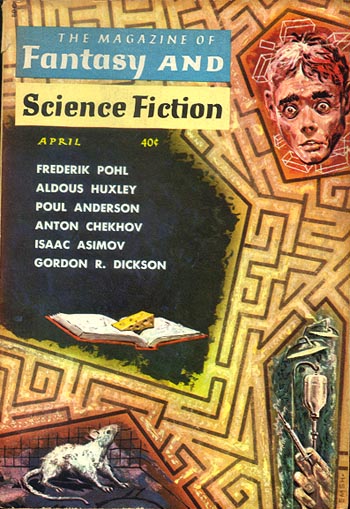Wow.
The April 1959 Fantasy & Science Fiction opens with a bang. The lead novella, Flowers for Algernon, is destined to go down as a classic, I'm sure.
But first, a quick detour to Asimov's column for the week. The old polymath (older than me–I don't turn 40 until tomorrow!) has been on a gloom kick lately. First it was melting ice caps. Now, he points out that the limiting factor to the density of life on Earth is the limited quantity of terrestrial phosphorous. Sure, there are lots of chemicals that are vital to life, but phosphorous is the one with the greatest imbalance between its concentration in living things and its abundance in nature.
Basically, living things have used up all the phosphorous, and if we want any more, we have to get it from the dead. In the ocean, this cycle is maintained by currents that scoop up dead creatures from the bottom and bring them to closer to the surface. On land, however, our rivers pour thousands of tons of soil into the ocean every year, and it comes back much more slowly than it leaves. COULD THIS SPELL DOOM FOR LIFE ON EARTH?
I suspect not. I am willing to wager that there is a nice equilibriating mechanism that we just haven't discovered yet, much like the one that regulates the ocean's salinity, sadly for those who wished to use the ocean's salinity as a yardstick to determine the age of the Earth.

But back to Flowers. Its writer is Daniel Keyes, who I know slightly from his work for Atlas Comics and as editor of the long defunct pulp, Marvel Science Stories. It follows the life of high-functioning moron Charlie Gordon, who wishes to become smarter. Diligent and good-natured, he is selected for a radical brain surgery that, if successful (as it had been for the eponymously named lab mouse, Algernon) will treble his I.Q.
The story is written in the style of a journal kept by Charlie. We get to see him progress from a barely functional human being to the highest level of genius–and then back down again. It turns out that the effect of the process lasts only a few weeks, barely enough time for Charlie to taste of brilliance before sinking to his former state.
What makes this novella is the writing. Keyes really captures the phases of Charlie's transformation. At first, Charlie is a simple person. Not childlike, which would have been, perhaps, easier to pull off. Just stupid, barely managing to write, and only after months of prior effort. Charlie is then made a genius, and that is when childishness enters the style, because Charlie is really a newborn at that point. He spends a lonely several weeks in virtual isolation, unable to communicate, as those he once found unspeakably brilliant become universally less gifted than he. This part resonated with me, a fairly bright person (though by no means a genius). I remember in 4th Grade, a teacher once chastised me saying, "you think you are so smart–how would you like it if everyone was as smart as you?" I replied, earnestly, "I'd love it! Then I'd have people to talk to!"
The poignancy of the story as Charlie declines and nearly dies is tear-jerking, but what really affected me was Charlie's condition at the end of the tale. He may still have an I.Q. of 68, but now he has the memory of being a genius. He is aware of his former place in society–a laughing-stock. Now Charlie burns to accomplish something, to recover, by the dint of his own effort, even the barest fraction of what he has lost.
And thus, we're left with hard questions: Is it better to have been smart and lost it than never to have been smart at all? Is ignorance bliss?
What do you think?
(Confused? Click here for an explanation as to what's really going on)
This entry was originally posted at Dreamwidth, where it has comments. Please comment here or there.

